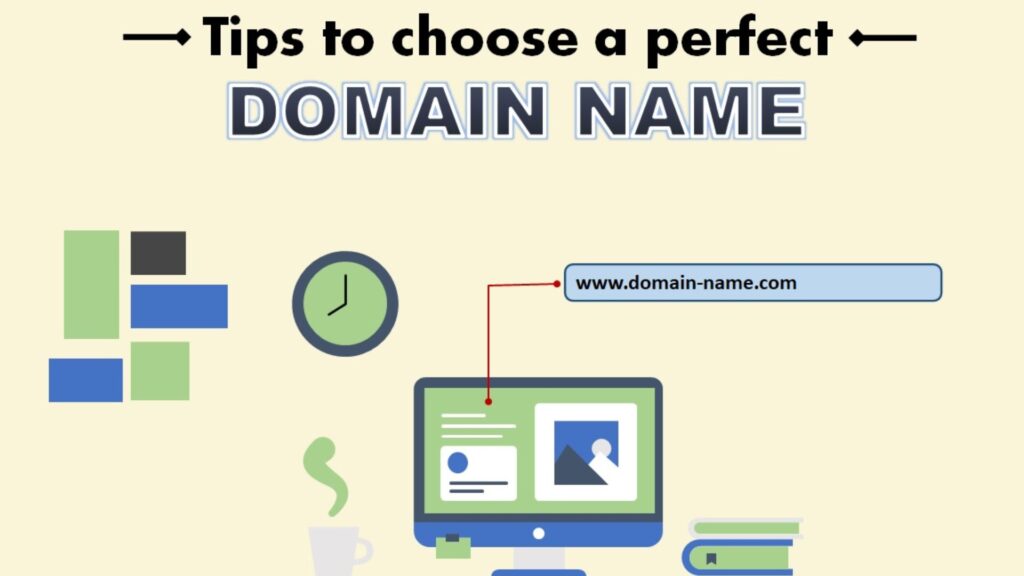Welcome to the dynamic world of affiliate marketing! Securing a domain name for your website is a pivotal step in carving your niche in the digital landscape. This comprehensive guide will walk you through the entire process, from understanding domain basics to choosing the right domain registrar. Discover the power of strategically selecting a keyword-rich domain name, ensuring availability, and implementing best practices for security.
Before delving into the registration process, let’s establish a solid understanding of domain name basics. A domain name consists of two main parts:
- Top-level domain (TLD)
- Second-level domain (SLD)

The TLD, like .com or .net, represents the general category, while the SLD is the unique part specific to your brand. Recognizing this structure is essential for making informed decisions during the registration process.
Step 1: Clearly Define Your Purpose
Before you even start searching for a domain name, take the time to articulate the purpose of your website. Understanding your goals will guide you in selecting a domain name that not only reflects your brand but also resonates with your target audience.

- Understand Your Audience: Identify your target audience by considering demographics, interests, and preferences. Tailor your domain name to capture their attention, making it memorable and relevant.
- Outline Content and Services: Clearly articulate the type of content or services your website will provide. Whether it’s a blog, e-commerce site, or portfolio, having a well-defined niche influences your choice of domain name.
- Research Competitors and Trends: Conduct thorough research on competitors and industry trends. Analyze successful websites in your niche and note emerging trends to inform your domain name selection.
- Brainstorm Keywords: Generate a list of keywords related to your website’s purpose. These keywords can enhance your domain name’s search engine visibility and relevance.
- Create a Mission Statement: Craft a concise mission statement that encapsulates your website’s essence. This statement serves as a guiding principle, ensuring your domain name aligns seamlessly with your overall vision.
By diligently defining your website’s purpose, you set the stage for a domain name that not only represents your brand but also speaks directly to your intended audience.
Check Your Affiliate Marketing Niches
Step 2: Choose the Perfect Domain Name
Selecting an effective domain name is a critical step in establishing your online presence. Dive into this process with careful consideration and strategic thinking to ensure that your chosen domain resonates with your audience and reflects the essence of your website.

- Clarity in Spelling and Pronunciation: Opt for a domain name that is easy to spell and pronounce. This ensures that potential visitors can effortlessly recall and share your website address. Avoid complex or confusing combinations of letters, symbols, or numbers.
- Memorable and Relevant Keywords: Incorporate relevant keywords related to your content or business into your domain name. This not only improves your website’s search engine visibility but also makes the name more memorable for users seeking specific information or services.
- Keep it Concise and Distinctive: Shorter domain names are generally more memorable. Aim for brevity while maintaining distinctiveness. Avoid unnecessary words or characters that might dilute the impact of your brand.
- Avoid Hyphens and Numbers: Hyphens and numbers can create confusion and make your domain name harder to remember. Opt for a seamless, uninterrupted name that flows naturally and is easier for users to type accurately.
- Leverage Domain Name Generators: Use domain name generators to spark creative ideas. These tools can suggest alternative combinations and variations based on your keywords, helping you discover unique and available options for your website.
By approaching the selection of your domain name with these detailed considerations, you set the stage for a web address that not only captures the essence of your brand but also enhances the user experience, making it easier for your audience to find and remember your website.
Buy your Best Domain & Hosting
Step 3: Check Domain Availability Thoroughly
Ensuring the availability of your chosen domain name is crucial for a successful registration. This step involves a meticulous exploration of potential names, preparing alternatives, and confirming their availability through a domain registrar’s search tool.

- Prepare a List of Potential Names: Start by brainstorming a list of potential domain names, considering variations and alternative options. This prepares you for the possibility that your first choice may already be taken.
- Utilize Domain Search Tools: Take advantage of the domain search tools provided by your chosen registrar. Input each potential name to check for availability. Pay attention to any suggestions or variations the tool may provide based on your input.
- Verify Alternative Extensions: While aiming for a .com extension is common, consider alternative extensions such as .net, .org, or industry-specific ones. Verify the availability of these extensions for your chosen domain name, providing flexibility in case your preferred option is unavailable.
- Check Social Media Handles :For branding consistency, verify the availability of your chosen domain name as a social media handle. This ensures a cohesive online presence across platforms, enhancing your brand recognition.
- Be Open to Adjustments: If your desired domain name is already taken, be open to variations or slight adjustments. Add prefixes or suffixes, incorporate hyphens if necessary, but ensure the final choice remains clear, memorable, and relevant to your website’s purpose.
By diligently following each subtitle in this step, you’ll navigate the domain availability process effectively, ensuring that your chosen name aligns with your brand, is easily accessible, and sets the tone for your online presence.
Step 4: Register Your Domain with Accuracy
Initiating the domain registration process requires attention to detail and accuracy. This step involves providing precise information to the registrar, opting for privacy protection, and ensuring that your registration aligns with legal and industry standards.

- Accurate Contact Information: Furnish the registrar with accurate contact information during the registration process. This includes your name, email address, and physical mailing address. Ensuring accuracy in this information is crucial for communication and domain ownership verification.
- Opt for WHOIS Privacy Protection: Consider opting for WHOIS privacy protection, a service offered by many registrars. This shields your personal contact information from being publicly accessible in the WHOIS database, enhancing your online privacy and reducing the risk of spam.
- Verify Registration Terms and Conditions: Carefully review and understand the registration terms and conditions provided by the registrar. Ensure compliance with industry standards and legal requirements. Be aware of renewal policies, transfer procedures, and any potential restrictions on your chosen domain.
- Double-Check Domain Name Spelling: Before finalizing the registration, double-check the spelling of your chosen domain name. Typos or errors in the registration process can lead to complications later on. Confirm that the domain name accurately reflects your intended choice.
- Keep Registration Information Secure: Safeguard the login credentials and registration information provided by the registrar. Store this information securely, as it will be crucial for managing your domain, making updates, and ensuring its continued accessibility.
By adhering to the subtitled considerations in this step, you’ll register your domain with precision, ensuring that your contact details are accurate, your privacy is protected, and you have a clear understanding of the terms and conditions associated with your domain registration.
Step 5: Choose the Right Domain Extension
Selecting an appropriate domain extension contributes significantly to your website’s identity. This step involves considering different extensions, understanding their implications, and choosing the one that aligns best with your website’s purpose and audience.

- Evaluate Popular Extensions: Begin by evaluating popular domain extensions, with .com being the most widely recognized. Consider extensions like .net, .org, .info, and others that might be relevant to your website’s content or industry.
- Consider Industry-Specific Extensions: Explore industry-specific domain extensions that align with your niche. For example, .tech for technology-related websites, .store for e-commerce, or country-code extensions like .uk or .au for localized relevance.
- Reflect on Global vs. Local Appeal: Determine whether a global or local appeal is more fitting for your website. If your audience is primarily global, a generic extension like .com might be suitable. However, if your focus is local, a country-code extension can enhance regional recognition.
- Protect Your Brand with Multiple Extensions:To safeguard your brand, consider registering multiple extensions for your chosen domain name. This prevents competitors from using a similar domain and ensures consistency across various online platforms.
- Stay Mindful of SEO Impact: Understand the potential SEO impact of your chosen extension. While it’s not a direct ranking factor, certain extensions may influence user trust and click-through rates. Choose an extension that complements your branding and SEO strategy.
By considering each you’ll make an informed decision on the right domain extension for your website. This choice not only enhances your brand identity but also contributes to the overall accessibility and recognition of your online presence.
Step 6: Add Domain Privacy Protection for Security
Protecting your personal information is paramount when establishing an online presence. This step involves opting for domain privacy protection, also known as WHOIS privacy, to shield your contact details from public access, mitigate spam, and enhance the overall security of your domain.

- Understanding WHOIS Information: Grasp the concept of WHOIS information, which includes the public details associated with domain ownership. This information is typically accessible to anyone through the WHOIS database unless privacy protection measures are in place.
- Benefits of Domain Privacy Protection: Recognize the advantages of domain privacy protection. This service conceals your personal information, such as your name, address, email, and phone number, replacing it with generic information. This not only protects your privacy but also reduces the risk of unsolicited communication.
- Minimize Spam and Unwanted Contacts: One of the primary benefits of privacy protection is the reduction of spam emails and unwanted contacts. By keeping your contact details private, you minimize the likelihood of your information falling into the hands of spammers and other malicious entities.
- Privacy Protection Fees: Be aware that domain privacy protection often comes with an additional fee. While this fee is typically nominal, consider it an investment in safeguarding your personal information and maintaining a secure online presence.
- Activation During Registration or Later: Understand the activation process for domain privacy protection. Some registrars offer this service as an opt-in during the initial registration process, while others allow you to activate it later through your account settings. Ensure that privacy protection is enabled promptly after domain registration.
By considering these points in this step, you fortify the security of your online identity, reduce the risk of unwanted communication, and create a safer digital environment for your website.
Step 7: Select a Reliable Hosting Provider
Choosing a hosting provider is a pivotal decision that directly impacts your website’s performance, accessibility, and overall user experience. This step involves evaluating different hosting options, considering features, reliability, and scalability to find the provider that aligns with your website’s needs.

- Assess Your Website’s Requirements: Begin by assessing your website’s requirements in terms of storage, bandwidth, and potential traffic. Understanding your needs will guide you in selecting a hosting plan that caters to your specific demands.
- Explore Hosting Provider Options: Research and explore various hosting providers. Popular choices include Hostinger, SiteGround, and HostGator. Consider factors such as server reliability, customer support, and additional features offered in their hosting plans.
- Customer Reviews and Testimonials: Gain insights from customer reviews and testimonials to understand the experiences of other website owners with a particular hosting provider. Pay attention to feedback related to uptime, performance, and the provider’s responsiveness to support queries.
- Scalability and Future Growth: Choose a hosting provider that offers scalability, allowing your website to grow seamlessly as your traffic increases. Assess the flexibility to upgrade your hosting plan and add features to accommodate future expansion.
- Integration with Domain Registrar: If convenience is a priority, consider a hosting provider that integrates seamlessly with your domain registrar. Some registrars offer hosting services, streamlining the process of managing both your domain and hosting from a single platform.
By carefully considering these points in this step, you’ll be well-equipped to choose a hosting provider that not only meets your immediate needs but also supports the long-term growth and success of your website.
Book Your Hosting Now With 7% OFF
Step 8: Link Your Domain to Hosting Account Seamlessly
Connecting your domain to a hosting account is a crucial step that ensures your website becomes accessible on the internet. This step involves updating nameservers, linking your domain to your hosting provider, and setting the stage for a seamless online presence.

- Retrieve Hosting Nameservers: Upon selecting a hosting provider, retrieve the specific nameservers assigned to your hosting account. This information is crucial for directing incoming traffic to the correct server where your website files are stored.
- Access Domain Registrar Settings: Access the settings section of your domain registrar’s platform. Locate the option for managing nameservers. This is where you’ll input the information obtained from your hosting provider to link your domain and hosting account.
- Update Nameserver Information: Enter the nameserver information provided by your hosting provider into the designated fields. This action informs the domain registrar where to direct requests for your website. This process may take some time to propagate across the internet.
- Confirm Successful Connection: After updating nameservers, confirm the successful connection between your domain and hosting account. Some registrars provide tools to check the status of nameserver updates. This confirmation ensures that visitors are directed to the correct server when accessing your domain.
- Troubleshooting if Needed: If any issues arise during the linking process, troubleshoot by double-checking the accuracy of the entered nameserver information. Contact both your hosting provider and domain registrar’s support teams if problems persist for prompt resolution.
By following this step, you’ll seamlessly link your domain to your hosting account, ensuring that your website is accessible to visitors and functions as intended on the internet.
Step 9: Set Up Your Website with Care
Now that your domain is registered and linked to your hosting account, it’s time to build and configure your website. This step involves choosing a website building platform, designing your site, and optimizing it for a positive user experience.
Grab the offer soon and earn money through your website
